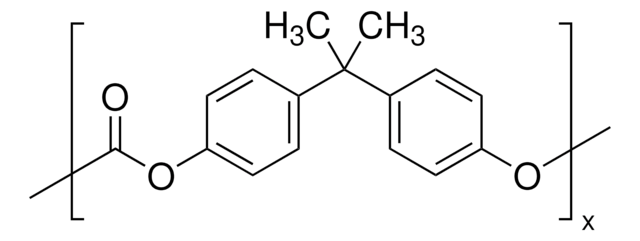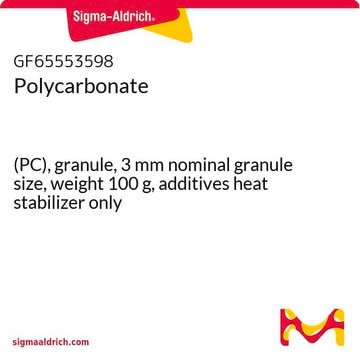375071
Bisphenol A bis(chloroformate)
95%
About This Item
Produits recommandés
Pureté
95%
Pf
90-92 °C (lit.)
Température de stockage
2-8°C
Chaîne SMILES
CC(C)(c1ccc(OC(Cl)=O)cc1)c2ccc(OC(Cl)=O)cc2
InChI
1S/C17H14Cl2O4/c1-17(2,11-3-7-13(8-4-11)22-15(18)20)12-5-9-14(10-6-12)23-16(19)21/h3-10H,1-2H3
Clé InChI
MMWCQWOKHLEYSP-UHFFFAOYSA-N
Catégories apparentées
Description générale
Application
- in the preparation of novel electro-optic (EO) polycarbonates containing two different kinds of nonlinear optical (NLO) chromophores with tricyanofurane (TCF) electron acceptor
- in the preparation of novel fluorine-containing poly(carbonate-block-siloxanes)
- as coupling reagent in the synthesis of block-copolymers containing poly(2,6-dimethyl-1,4-phenylene oxide) (PPO) and polycarbonate of bisphenol A (PC) segments
Mention d'avertissement
Danger
Mentions de danger
Classification des risques
Acute Tox. 3 Oral - Eye Dam. 1 - Skin Corr. 1B
Code de la classe de stockage
6.1A - Combustible acute toxic Cat. 1 and 2 / very toxic hazardous materials
Classe de danger pour l'eau (WGK)
WGK 3
Point d'éclair (°F)
Not applicable
Point d'éclair (°C)
Not applicable
Équipement de protection individuelle
Eyeshields, Faceshields, Gloves, type P2 (EN 143) respirator cartridges
Certificats d'analyse (COA)
Recherchez un Certificats d'analyse (COA) en saisissant le numéro de lot du produit. Les numéros de lot figurent sur l'étiquette du produit après les mots "Lot" ou "Batch".
Déjà en possession de ce produit ?
Retrouvez la documentation relative aux produits que vous avez récemment achetés dans la Bibliothèque de documents.
Les clients ont également consulté
Notre équipe de scientifiques dispose d'une expérience dans tous les secteurs de la recherche, notamment en sciences de la vie, science des matériaux, synthèse chimique, chromatographie, analyse et dans de nombreux autres domaines..
Contacter notre Service technique












